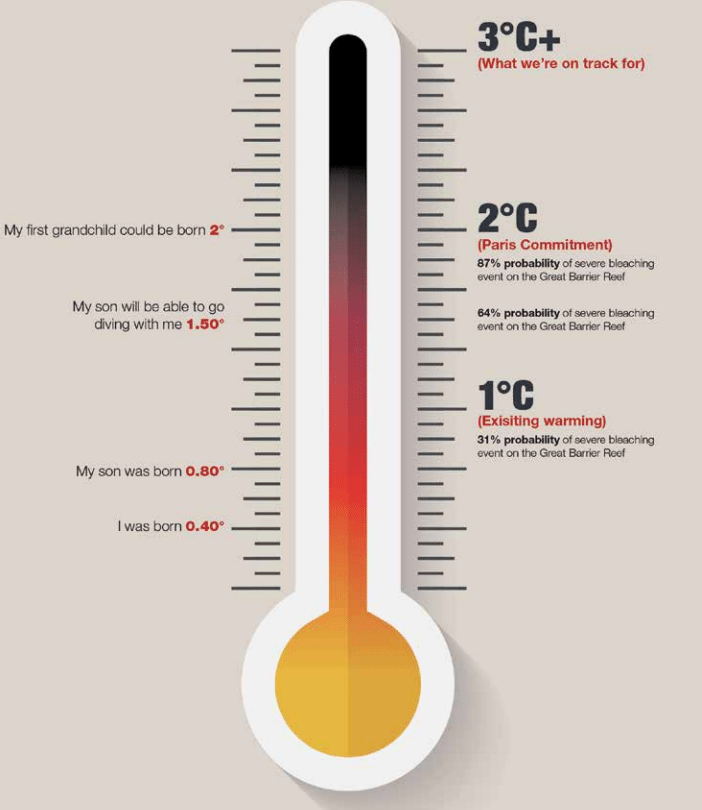We are witnessing the consequences of climate change right now, so what kind of reef will young people inherit? The choice is ours.
We are witnessing the consequences of climate change right now, so what kind of reef will young people inherit? The choice is ours.
Dr Jennie Mallela is ARC DECRA Fellow at the Australian National University and has been conducting research on reconstructing long-term environmental change and documenting effects on coral reef organisms on the Great Barrier Reef. She has two decades of experience in marine research, monitoring, conservation, marine protected areas, environmental monitoring and environmental education. Jennie shares her research and her hopes that her son will be able to see the Great Barrier Reef.
I’ve been lucky enough to work on coral reefs around the world over the last 20 years. I can’t wait until my son is old enough to come with me and be my dive buddy. He’s only three now and he has to be ten years old and a good swimmer before he can SCUBA dive. I often think about where I will take him on his first dive —I want it to be a healthy reef with AMAZING underwater life, big fish, turtles, manta rays and even a friendly shark or two. But at this point, I honestly don’t know what reefs, if any, will be in good condition in seven years’ time.
Corals can recover from bleaching events such as the ones that the Great Barrier Reef has experienced over the past two years, but they need time and the right conditions (cooler and cleaner water)—something we don’t seem to be giving them. Without the coral, the reef fish have nowhere to live. Without the fish, the sea birds and—yes, humans—go hungry in many places around the world. Without the reefs our shorelines won’t be protected during storms, cyclones and hurricanes. The loss of the Great Barrier Reef is a collective loss for humanity, although I experience it in a very personal way.
So what am I doing to ensure that my son—as well as millions of others—has the opportunity to experience the same wonders that I have? I think the most important thing I can do is tell people what is happening, and let them know it’s not hopeless. It is not too late for the Australian Government to take serious steps to respond to the number one threat to the Great Barrier Reef—climate change—and to give it a fighting chance.
A window to act
The thermometer below shows the increasing probability of coral sea heat temperatures reaching the same levels that occurred in 2016, resulting in unprecedented coral bleaching and severe coral die-off.
As the world warms, the chance of these events occurring increases. 1.5 degrees Celsius may be the maximum level of global warming that can occur for coral reefs to still be able to recover.[1] There may only be a three year window left to reduce emissions to stay below 1.5 degrees of warming.[2]

DATA: King, A. et al. Pursuit by the University of Melbourne, ‘Heating Up: How rises in global temperature could damage the Reef’, 16 May 2017, accessed 29 June 2017, https://pursuit.unimelb.edu.au/ articles/heating-up-how-rises-in-global-temperature-could-damage-the-reef
This article was originally published in Greenpeace’s report: ‘The double threat to the Great Barrier Reef: Climate change and the Australian Government’. The report was published ahead of the 41st meeting of the UNESCO World Heritage Committee to highlight the Australian Government’s failure to protect the Reef.
[1] Hunte, E., The Guardian, ‘Paris agreement’s 1.5C target ‘only way’ to save coral reefs, Unesco says’, 24 June 2017, accessed 25 June 2017, <https://www.theguardian.com/environment/2017/jun/24/paris-agreements-15c-target-onlyway-to-save-coral-reefs-unesco-says%3E>
[2] Harvey, F., The Guardian, ‘World has three years left to stop dangerous climate change, warn experts’, 29 June 2017, accessed 29 June 2017, <https://www.theguardian.com/ environment/2017/jun/28/world-has-three-years-left-to-stopdangerous-climate-change-warn-experts>


